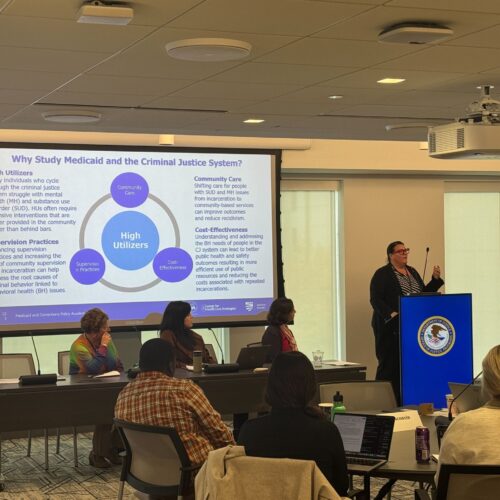Juvenile Justice Research-to-Practice Implementation Resources
family engagement
The Juvenile Justice Research-to-Practice Implementation Resources provide juvenile justice agency managers, staff, and other practitioners with concrete strategies, tools, examples, and best-practice models to help them implement research-informed policies and practices and improve outcomes for youth in the juvenile justice system.
Access the available resources on Family Engagement and Involvement and Evidence-Based Programs and Services below.
Family Engagement and Involvement
Research shows that youth who have supportive caregivers have better outcomes than youth with less supportive caregivers. This is true across the juvenile justice, child welfare, behavioral health, and education systems. Youth whose caregivers do not provide consistent structure and support are at far greater risk of engaging in continued delinquent behavior and suffering poor behavioral health, education, and employment outcomes into adulthood. But practitioners often struggle to implement family engagement and involvement policies and practices effectively. Below are suggested strategies, tools, examples, and best-practice models from across the country that juvenile justice agency managers, staff, and other practitioners may consider adopting to effectively implement family engagement practices and promote positive outcomes for youth in the juvenile justice system.
Identifying family members or other supportive adults who can promote positive outcomes for youth
Strategy 1: Define “family” broadly.
Family should be understood to include traditional and non-traditional caregivers and other supportive adults. The family and youth should name those who are considered family.
Strategy 2: Identify family members and other supportive adults using visual tools, questionnaires, and other models developed by the field.
- Employ Family Finding, an approach borrowed from the child welfare field, which seeks to connect all youth to supportive adults.
- Refer to Six Steps to Find a Family: A Practice Guide to Family Search and Engagement, which supports practitioners in identifying and engaging family and other supportive adults for youth both in the community and in out-of-home placements.
- Use genograms and eco-maps, visual tools that help practitioners facilitate conversations with youth and family members.
- Complete the Family Case Management Flowchart, which uses a broad definition of “family” to facilitate the identification of both family relationships and community supports.
- Work with the Juvenile Relational Inquiry Tool (JRIT), a series of questions designed to help practitioners identify family members and other supportive adults and build a rapport with them.
Supporting families in navigating the juvenile justice system and remaining involved with their children
Strategy 1: Establish a culture of alliance with families who have children in the juvenile justice system.
- Train staff to ensure that all practitioners who work with youth have the skills to communicate with families in a way that recognizes and validates their experience, culture, concerns, and needs.
- Carry out family-focused policies and practices across the juvenile justice continuum.
Strategy 2: Educate families about their children’s experience in the justice system.
- Supply family guides to introduce family members to the structure, procedures, staff roles, and terminology of the juvenile justice system and how they may advocate for and support their children within that system.
- Develop a parents of incarcerated children “bill of rights,” a short resource that educates parents on their rights and opportunities to be involved with their children who are under system supervision.
Strategy 3: . Provide peer supports.
- Enlist family engagement specialists or family advocates, people who help families understand the system and stay connected to their children, and whose own children may have been in contact with the juvenile justice system.
- Organize parent and peer support groups and family councils, which bring together multiple families of youth in the juvenile justice system to learn from and support each other, as well as inform juvenile justice policy and practice.
Strategy 4: Outreach to families.
- Consider recommendations related to the treatment of families throughout the case continuum, a roadmap for practitioners working with the families of youth at different stages of involvement with the juvenile justice system.
- Consult Families Unlocking Futures: Solutions to the Crisis in Juvenile Justice, which provides an overview of recommendations from families of incarcerated youth on how to effectively engage and involve them.
- Develop scripts for staff who are initiating outreach to a youth’s family or caregivers prior to meeting in person.
Engaging families to play an active role in youth’s case planning and treatment
Strategy 1: Involve families in supervision and service decisions.
- Implement family team meetings, Family Group Decision Making, or Effective Practices in Community Support for Influencers, models that include youth’s caregiver networks in collective decision making on case planning, services, and supervision.
- Adopt the evidence-based Functional Family Probation model, wherein probation officers engage with and provide case management to the families of youth who are under community supervision.
- Introduce Functional Family Therapy, Multi-Dimensional Treatment Foster Care, or Multi-Systemic Therapy, three programs with strong evidentiary support that aim to provide intensive, in-home family therapy.
Strategy 2: Provide opportunities for family contact with youth placed in facilities.
- Implement flexible and inclusive family visitation hours and policies, which increase youth’s contacts with supportive adults and lead to positive outcomes.
- Offer transportation assistance to families in order to promote more frequent contact with children who are placed in residential facilities.
- Use communication technology, which helps support—but should not replace—family contact when in-person meetings are difficult to arrange.
- Consider requiring family contact and engagement as part of supervision policy and practice for youth in the community and in facilities.
- Hold family days, graduations, performances, Mother’s/Father’s Day gatherings, and youth celebration events to bring families together and connect them with their children.
Establishing and tracking family engagement performance measures
Strategy 1: Solicit family input on agency policies, practices, and outreach efforts.
- Establish family and youth advisory groups who are tasked with regularly reviewing agency policies and practices and ensure that they are family friendly.
- Administer family surveys to assess and continually improve upon the agency’s family engagement efforts.
- Conduct focus groups with youth in the juvenile justice system and their families to gain valuable insights on how to improve family engagement.
Strategy 2: Hold staff accountable for family outreach and support.
- Consider taking part in Performance-based Standards (PbS) for Youth in Correction and Detention Facilities, a program that requires participating agencies to survey families and youth to gather feedback about facility conditions, staff, services, and overall satisfaction with their experiences.
- Formally assess juvenile performance with regard to family engagement at all points across the juvenile justice continuum.
Evidence-Based Programs and Services
Programs and services are considered evidence based when they have demonstrated effectiveness through scientific research and evaluation. Both research and field experience show that implementing evidence-based programs and services with fidelity correlates to reduced recidivism rates and improved outcomes for youth. Once juvenile justice agencies and contracted service providers institute such programs and services, however, they often encounter challenges in identifying the appropriate services and implementing them properly, consistently, and in ways that lead to better outcomes for youth. Among other approaches to these challenges, there are opportunities for state policymakers to enact legislation and funding incentives to encourage the adoption of effective service approaches at the state and local levels. Below are suggested strategies, examples, and best-practice models from across the country that state policymakers, juvenile justice agency administrators and managers, staff, and other practitioners may consider adopting to promote and effectively implement evidence-based programs and services with fidelity.
Identifying, funding, and promoting evidence-based programs and services
Strategy 1: Consult resources in the field to identify programs and services that have been shown by research to reduce recidivism and improve other outcomes for youth in the juvenile justice system.
- Blueprints for Healthy Youth Development is a clearinghouse of programs with the best evidence of improving outcomes for youth in the juvenile justice system.
- The National Institute of Justice’s CrimeSolutions.gov assesses program research to rate the effectiveness of juvenile justice programs and practices to improve outcomes for youth and adults.
- The Office of Juvenile Justice and Delinquency Prevention’s Model Programs Guide contains information about evidence-based juvenile justice and youth prevention, intervention, and reentry programs.
- The Results First Clearinghouse Database, developed by the Pew Charitable Trusts and the John D. and Catherine T. MacArthur Foundation, summarizes the effectiveness of various program and service interventions as rated by eight national research clearinghouses.
- The Substance Abuse and Mental Health Services Administration’s National Registry of Evidence-Based Programs and Practices is an online registry of more than 350 substance use and mental health interventions that is searchable by age range, population, and other criteria.
Strategy 2: Require the use of programs and practices that are evidence based.
- Tennessee’s evidence-based law requires state agencies to ensure that all state funds for juvenile justice programs are spent only on evidence-based programs.
- Washington State’s weighted funding formula provides additional funding to local juvenile justice systems that place youth in evidence-based programs and services.
- Oregon requires that all agencies receiving state dollars spend a percentage of funds on evidence-based programs and services, and submit reports assessing state-funded programs.
Strategy 3: Provide or increase funding for evidence-based programs and services.
- Wraparound Milwaukee, a managed care program operated by the Milwaukee County Behavioral Health Division, pooled funding from multiple child-serving systems in Milwaukee County and the state Medicaid Agency to finance evidence-based programs and services for youth in the juvenile justice system.
- The Louisiana Department of Health amended its state Medicaid plan to cover evidence-based programs for youth in the community such that juvenile justice agencies may leverage the plan to increase service availability.
- Targeted RECLAIM, an initiative of the Ohio Department of Youth Services, funds local jurisdictions to use model and evidence-based programs to divert eligible youth who have committed felonies from state custody into effective community-based alternatives.
- Louisiana’s Juvenile Justice Reinvestment Program funds evidence-based programs in the community through contracts wherein funding is tied to program performance.
- Federal funding opportunities support the adoption and implementation of evidence-based programs and services for youth in the juvenile justice system.
- North Carolina has a state statute that funds training and technical assistance opportunities for evidence-based juvenile justice programs and practices.
Strategy 4: Ensure that competitive requests for services and service provider contracts require the use of programs and services that are evidence based.
- The Georgia Criminal Justice Coordinating Council and the Pennsylvania Commission on Crime and Delinquency released requests for proposals to support the implementation and expansion of evidence-based programs and services.
- The Dallas County, Texas, Juvenile Department’s contracts with service providers outline clear guidelines for the use of evidence-based programs and services.
Matching youth to services based on their assessed risk of reoffending and criminogenic needs
Strategy 1: Develop registries of service providers that specify their program model and target population.
- The Nebraska Judicial Branch has a website that lists registered service providers and identifies the array of programs and treatment available to youth in regions across the state.
Strategy 2: Adopt standardized case-planning and service-matching policies, tools, and templates.
- The Utah Juvenile Court, in collaboration with the Utah Division of Juvenile Services, developed a case planning toolkit that establishes detailed performance criteria for conducting and using risk and needs assessments to match youth with appropriate services.
- The Louisiana Office of Juvenile Justice uses a service matrix to link youth to programs and services based on the results of screening and assessment.
- The Florida Department of Juvenile Justice’s disposition matrix provides guidance on using risk level and the seriousness of the offense to match adjudicated youth with the appropriate placement.
Providing agency staff and service providers with sufficient training and oversight, and enacting quality assurance measures
Strategy 1: Establish standards of service quality and assess adherence to program models.
- The Washington State Institute for Public Policy developed a set of quality control standards for the state’s evidence-based juvenile justice programs.
- The Standardized Program Evaluation Protocol and the Correctional Program Checklist tools identify standards of effective programs and assess how closely programs and services adhere to these standards.
- The Milwaukee County, Wisconsin, Department of Health and Human Services (DHHS) Delinquency and Court Services Division implemented a Continuous Quality Improvement (CQI) Cycle for assessing department programs and community services.
- The Pennsylvania EPISCenter instituted a Program Developer’s Fidelity Verification Rating and Checklist to assess whether programs adhere to the developer’s model.
Strategy 2: Train and oversee agency staff and service providers in implementing evidence-based programs and services with fidelity.
- The West Virginia Department of Military Affairs and Public Safety established the Justice Center for Evidence-Based Practice, which supports research, effective planning and coordination, and the use of evidence for informed decision making.
- The Colorado Division of Criminal Justice’s Evidence-Based Practices Implementation for Capacity Resource Center assists agencies serving juvenile and adult justice populations in developing, implementing, and sustaining evidence-based practices.
- The Milwaukee DHHS’s Delinquency and Court Services Division trains community-based service providers on quality assurance.
- The Connecticut Center for Effective Practice (CCEP)—a division of the Child Health and Development Institute of Connecticut jointly funded by Connecticut’s Department of Children and Families and the Court Support Services Division of the state judicial branch—provides information on best practices in child mental health and helps implement evidence-based practices through training, evaluation, and expansion of effective models of practice. One of CCEP’s functions is to administer training and quality assurance for all of the state’s Multisystemic Therapy programs, which provide intensive, in-home family therapy for youth who have become involved with the juvenile justice system.
- The Pennsylvania EPISCenter provides counties and service providers with (1) resources, training, and technical assistance for program selection and start-up, (2) model adherence and quality assurance, and (3) data collection and outcome measurement.
Collecting, using, and reporting data on service provider outcomes to guide service and funding decisions
Strategy 1: Set target outcomes and performance standards for services provided to youth in the juvenile justice system.
- The Florida Department of Juvenile Justice has monitoring and quality improvement standards for its various programs and services, including detention, residential placement, and probation and community interventions.
- Performance-based Standards (PbS) for Youth Correction and Detention Facilities is a program that encourages agencies and facilities to use national standards and outcome measures to improve services for youth who are incarcerated.
- The Standardized Program Evaluation Protocol emphasizes four areas of information that are critical for demonstrating program effectiveness: service category, quality of service delivery, amount of service (i.e. dosage), and risk level of youth served.
Strategy 2: Establish policies, systems, and tools for service providers to collect and report data on youth progress and outcomes in services.
- The Utah Division of Juvenile Justice Services (JJS) requires contracted service providers to report on the outcomes of youth in their programs. JJS then analyzes these data, summarizes them in a graphical report, and supplies the report to service providers. Download a sample report spreadsheet.
- The Pennsylvania Commission on Crime and Delinquency requires data collection and reporting from providers that are receiving Violence Prevention Program funds. Download a sample data collection spreadsheet.
- The Pennsylvania EPISCenter has developed resources to support standardized and valid data collection, including a guide and a corresponding data collection and analysis tool for providers that have adopted Aggression Replacement Training, an evidence-based program that trains youth on social skills, anger control, and moral reasoning. Download the EPISCenter’s data collection and analysis tool.
- Per state legislation, the Texas Juvenile Justice Department collects supervision and service outcome data from local probation agencies and reports biannually on these data.
- The Florida Department of Juvenile Justice has a comprehensive data system for department staff and contracted service providers that links prior history, risk-based referrals, services received, and outcomes for every juvenile who enters the system.
Strategy 3: Institute formal service review, accountability, and improvement processes.
- The Florida Department of Juvenile Justice developed an accountability system for each provider that contracts with the department for service delivery to youth.
- The Milwaukee County DHHS requires that providers develop an annual action plan for program improvement.
- The Standardized Program Evaluation Protocol in Pennsylvania features a performance improvement guide for juvenile justice service providers and a corresponding downloadable performance improvement plan template.
Additional Resources
For additional resources on applying research in juvenile justice practice, please see the Bridging Research and Practice Project to Advance Juvenile Justice and Safety.
Acknowledgments
These products are the result of a collaborative effort among CSG Justice Center staff and juvenile justice experts, practitioners, and advocates from across the country. The CSG Justice Center is grateful for the support and leadership of staff at the Office of Juvenile Justice and Delinquency Prevention.
Thanks to these advisors and partners who generously gave their time and expertise*:
• Grace Bauer, Executive Director, Justice For Families
• Shay Bilchik, Director, Center for Juvenile Justice Reform, McCourt School of Public Policy, Georgetown University
• Stephanie Bradley, Director, Principal Investigator, The Evidence-based Prevention and Intervention Support Center
• John DeWitt, Director of the Bureau of Research and Evaluation, Utah Division of Juvenile Justice Services
• Dan Edwards, President, Evidence-Based Associates
• Peter Greenwood, Executive Director, Association for Advancement of Evidence-Based Practices
• Samantha Harvell, Senior Research Associate, Urban Institute
• Dan Jackson, Executive Director, Nebraska Family Support Network
• Mark Lipsey, Director, Peabody Research Institute; Research Professor, Peabody College of Education and Human Development, Vanderbilt University
• Ned Loughran, Executive Director, Council of Juvenile Correctional Administrators
• Wendy Luckenbill, Senior Recovery and Resilience Specialist for Children, Youth, and Their Families, Community Care Behavioral Health
• De Shell Parker, Administrative Coordinator, Quality Assurance, Delinquency and Court Services Division, Milwaukee County, Wisconsin, Department of Health and Human Services
• Stephen Phillippi, Director, Institute for Public Health and Justice, Louisiana State University
• Ryan Shanahan, Research Director, Vera Institute of Justice
• Cara Stirts, Deputy County Attorney, Douglas County, Nebraska, Attorney’s Office, Juvenile Division
• Michael Umpierre, Senior Research Fellow, Center for Juvenile Justice Reform, McCourt School of Public Policy, Georgetown University
• Clay Yeager, Senior Consultant, Evidence-Based Associates
* All titles reflect the positions held at the time of project involvement.
The CSG Justice Center is especially grateful to the following organizations for their permission to publish supplemental documents as part of the Juvenile Justice Research-to-Practice Implementation Resources: Delinquency and Court Services Division, Milwaukee County, Wisconsin, Department of Health and Human Services; Utah Division of Juvenile Justice Services; Evidence-based Prevention and Intervention Support Center; Justice For Families; Institute for Public Health and Justice, Louisiana State University; Division of Youth Services, Missouri Department of Social Services; Dallas County, Texas, Juvenile Department; and Douglas County, Nebraska, Attorney’s Office, Juvenile Division.
When returning to their communities from criminal justice settings, people with behavioral health needs face barriers in accessing…
Read MoreNew Hampshire Department of Corrections Commissioner Helen Hanks presents at the Medicaid and Corrections Policy Academy in-person meeting.
Read MoreThe Council of State Governments (CSG) Justice Center has launched the Collaborating for Youth and Public Safety Initiative…
Read More Assigned to the Cloud Crew: The National Incarceration Association’s Hybrid Case Management for People with Behavioral Health Needs
Assigned to the Cloud Crew: The National Incarceration Association’s Hybrid Case Management for People with Behavioral Health Needs
When returning to their communities from criminal justice settings, people with behavioral health needs face barriers in accessing basic needs—including food, housing, employment, transportation, education, clothing, and substance use and mental health services—which increases their risk of experiencing a crisis.
Read More Meet the Medicaid and Corrections Policy Academy Mentor States
Meet the Medicaid and Corrections Policy Academy Mentor States
New Hampshire Department of Corrections Commissioner Helen Hanks presents at the Medicaid and Corrections Policy Academy in-person meeting.
Read More Six States Commit to Improving Statewide Strategies to Address Youth Crime, Violence and Behavioral Health
Six States Commit to Improving Statewide Strategies to Address Youth Crime, Violence and Behavioral Health
The Council of State Governments (CSG) Justice Center has launched the Collaborating for Youth and Public Safety Initiative (CYPSI) in partnership with six states: California, New Mexico, New York, Ohio, Oklahoma, and Rhode Island. The initiative will help states develop, fund, and effectively implement a research-based service continuum to improve public safety and behavioral health, education, and other outcomes for youth.
Read More Bipartisan Group of 88 Lawmakers Push for Continued Funding for Reentry and Recidivism Programs
Bipartisan Group of 88 Lawmakers Push for Continued Funding for Reentry and Recidivism Programs
A bipartisan group of 88 lawmakers, led by Representatives Carol Miller (R-WV) and Danny Davis (D-IL), wrote a letter calling for continued funding for the Second Chance Act in the Fiscal Year 2026 Commerce, Justice, Science, and Related Agencies appropriations bill.
Read More









